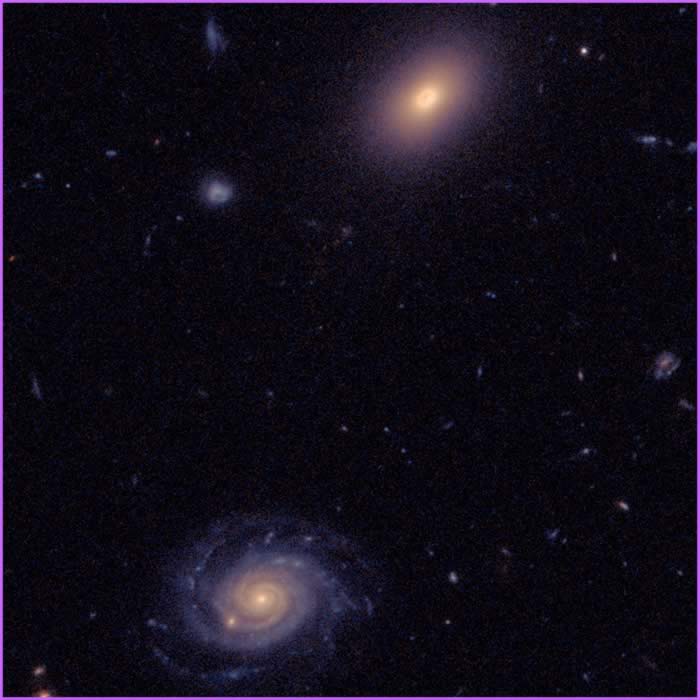 |
 |
Two Families: Spiral Galaxies and Elliptical Galaxies |
|
This portion of the AEGIS field contains two galaxies that have similar sizes and brightnesses. They are also about the same distance away from us, so they are close together in real space, as well as close together on the sky. They are probably bound together by their common gravity as part of a galaxy group. However, these galaxies have very different appearances. They are proto-typical examples of the two main classes of galaxies: spirals and ellipticals. |
Spiral galaxies, such as the one to the lower left, are continually forming stars in their spiral arms. The bright blue clumps dotted along the spiral arms are sites of intense star formation. Their light is dominated by massive, hot stars that burn very intensely but have short lifespans before exploding as supernovae. Smaller stars burn more slowly and at lower temperatures. They live as much as 10,000 times longer than the most massive stars and produce redder light. In areas of ongoing star formation, the very luminous massive stars dominate the light and make the galaxy look blue, but once star formation ceases, these stars die out quickly, leaving a population of older, redder stars. The center of the spiral galaxy is redder and less clumpy than the outer parts of the arms, indicating that this part of the galaxy harbors much less active star formation. |
It is immediately obvious that elliptical galaxies, like the one to the upper right, are very different from spiral galaxies. They do not have detailed spiral structure. They are in fact more spheroidal, like fuzzy rugby balls in the sky, whereas spirals are relatively flat and disc-shaped. This difference in shape is due to the way that stars orbit the center of the galaxy. Stars in the disk of a spiral galaxy all orbit in the same direction, like water molecules swirling around the drain in a bathtub. Stars in ellipticals, on the other hand, can orbit in all different directions without coherent rotation. |
Ellipticals look relatively smooth, lacking the bright clumps of stars seen in spirals. They also tend to have redder colors. Both the red color and the lack of bright star-forming clumps suggest that elliptical galaxies do not experience much active star formation. It is not obvious in optical images like this one, but radio observations reveal that ellipticals also contain much less cold gas than do spirals. This may be a partial explanation of why ellipticals are not actively forming stars: they do not contain the reservoirs of cold gas needed for star formation. |
There are also galaxies that do not fit neatly into one of these two simple categories. There are galaxies with properties intermediate between the two types that large red spheroidal components like an elliptical galaxy but that also show obvious disks. The Sombrero Galaxy (NGC 4594) is a famous example these intermediate galaxies. There are also irregular and asymmetric galaxies. Some irregular galaxies are thought to be two galaxies caught in the act of merging into a single galaxy. There are several nice examples of these in the AEGIS survey. How many different types of galaxies can you find browsing through AEGIS in Google Sky? |